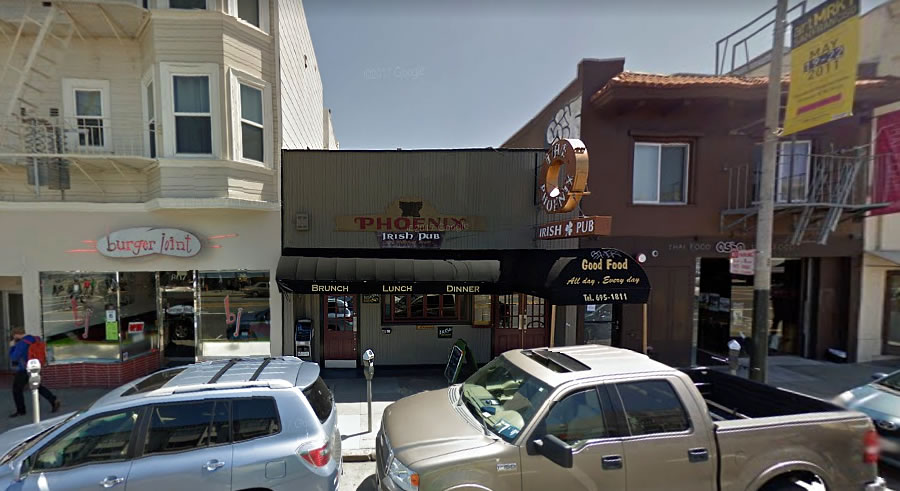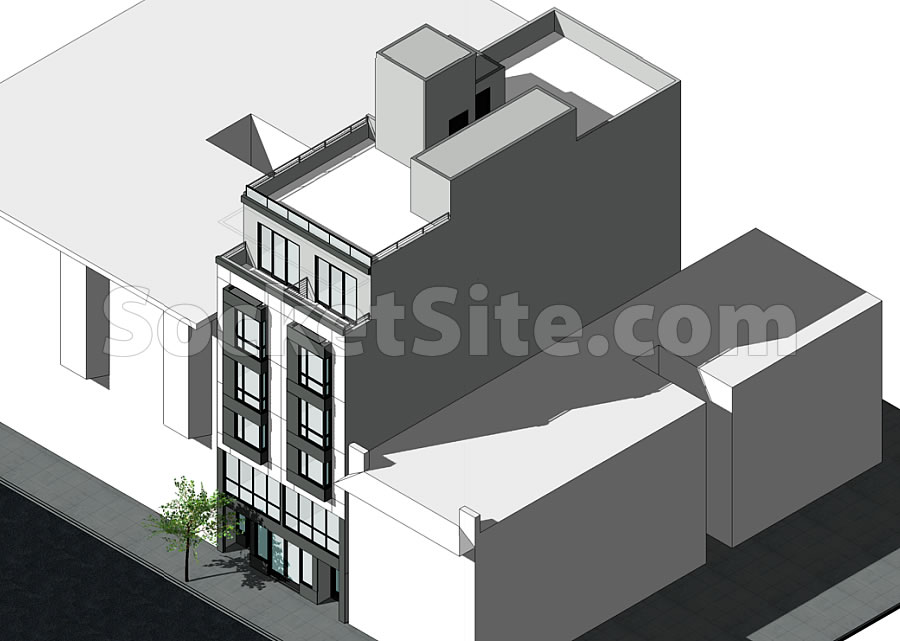Plans to level the Phoenix Irish Bar & Gathering House at 811 Valencia Street are in the works.
And as currently envisioned, a six-story building would rise up to 55 feet in height upon on the Mission District site, with 20 single-room occupancy (SRO) units over a little ground floor commercial space and off-street parking for 20 bikes.
We’ll keep you posted and plugged-in.


Building SRO’s…..? HOW AWFUL ICK
why is it awful?
I’d also like to know
Oh no! People on the street will have a new option housing?!?!
SROs are better than dealing with tyrannical master tenants
knee jerk response. You assume the tenderloin mess. And they didn’t start out the way they’ve become.
MEDA’s next press release: “We oppose the development proposed for 811 Valencia as this Irish bar is an important historical and cultural resource for this traditionally Latino neighborhood.”
“…that was Irish and German before it was Latino”
(that’s the joke)
Absolutely not! DR this to death. Many more suitable sites for such a development
Presidio Terrace comes to mind.
“Hi, Mrs. Feinstein – I’m your new neighbor. Can I borrow a cup of sugar? (looking around). Nice place you got here. Do you party?”
Why is this not a suitable site?
Yeah like western soma, the city dumping ground. I mean honestly what “more suitable sites” ya have in mind? Let’s share the wealth. Rehab and detox centers, recycle centers, shelters…and SROs….we need them in every district, why are they all dumped into soma?
I think it’s completely reasonable to be pissed when long-time, seemingly successful businesses (albeit bars) are bought up and torn down. Granted this will likely turn into years of “not yet, but soon” just like what’s happened to Elbo Room down the street; so maybe it’s not pitchfork-and-torch-worthy news.
Why isn’t a density bonus (and two more stories) part of this plan?
Does the density bonus apply to SROs?
Agree, this is WAY too short.
No, 6 stories is not “WAY too short” – it’s a very human scale that people like (see: central Paris, central London, lower Manhattan, Back Bay, etc.). And that’s doubly true for such a narrow lot as this, where a taller building would look very out of place.
density bonus would require more affordable units than required
SROs: Tomorrow’s slums today!
Exactly
YUCKY
You’ve described what the entire city has transformed into
Amen. I’d like to believe San Francisco still has heart, but many of have left anyway. S/he’s in the bona-fide idiot league with Futurist, an architect, who unbelievably refers to needy populations as ‘human trash’. Their fantasies that they are apart is fragile and clearly fear based.
There’s little difference between SRO’s and micro units. They fill a desperate need for housing of our increasingly single, unattached adult population, not only in SF but nationwide.
people who think this will be a “slum” — it will be occupied by 20-somethings just out of college and making a ton of money at a tech firm. the term “SRO” does not imply low-income. in the case of Valencia Street, it will be dorms for recent techy college grads.
> it will be occupied by 20-somethings just out of college and making a ton of money at a tech firm
So, that’s going to be written into the CC&Rs? 30 years from now (heck, 3) there are still going to be tech firms hiring 20-somethings?
The existing SROs in the Tenderloin were built in the 1920s /30s / 40s to house single blue-collar and white-collar workers – stenographers, accountants, mechanics, etc. Nothing wrong with that in the 1920s / 30s / 40s … but you can’t freeze a neighborhood or a land use in place for all time, and SROs are simply far more likely than other building types to fall into “lowest common denominator” rents (and hence disrepair and quality).
I’ve heard SROs had blue collar workers until the 1980’s
Maybe the last 30 years are the anomaly made worse by bad government policy.
The Tenderloin was going to be razed and replaced by hotels (like the Union Square Hilton which replaced a whole city block in the early 80s) until the historic buildings were landmarked and for better or worse prevented from teardowns or condo conversions. Low rent housing is the only feasible use left.
How about a co-living space instead? With Bosch or Miele appliances, rain showers, meditation rooms, catered meals, fun classes, and yoga with building mates and separate co-working space.
I might have listed my own requirements to move in.
There’s nothing wrong with SRO units or having a diverse housing supply. Don’t like it – don’t live there.
Factory OS builds modular SRO’s for 125k per door, excluding soft and foundation and siding costs. The guy who ran Bridge Housing I believe.
The Planning Dept application packet shows that these units all have their own individual bathrooms and kitchens. Plans look more like studios than SRO design.
Also, the 20 bicycle parking spaces are actually a rack in the back yard with no shelter. Bike riders must walk their bike from the front door through a zig zag path leading all the way to the rear yard.
Many of the proposed “Units” are too small to qualify as Studio (Dwelling) Units.
So this is technically an SRO-Group Housing project.
Additionally, the street-level Commercial space does not meet Planning Code floor-to-floor height — which must be 14 feet minimum.
Accordingly, in order to deal with this requirement, either the Commercial becomes a Lobby or the 2 Units currently above it must be eliminated — making this an 18-Unit project.
I’d wager it’ll be the latter, as Planning will require some kind of Commercial space at the street-level on any project that is within this very active section of Valencia.
Technically Group Housing projects have no Rear Yard requirement, so they’re free to put the bikes in the “back yard” — however, I believe your correct to assume that Planning will require that they are enclosed/protected from the elements.
Overall, at present, this project is rather sloppily worked out.
Valencia Street NCT zoning rear yard requirements:
“Required at the Second Story and at each succeeding level or Story of the building, and at the First Story if it contains a Dwelling Unit: 25% of lot depth, but in no case less than 15 feet”
This lot is 80 feet’ deep, 25% of which is 20 feet
high tech shiny slums to be sold at high prices and called “affordable”
you people…deserve an expensive [city] like SF. hope you all choke on your smug self righteousness when the time comes
What’s hilarious about this is the 20 somethings only want to live here in such small spaces because of all the bars and restaurants, and the grunge factor made it cool. As the bars and grunge disappear, so will the 20 somethings. And when the restaurants are all replaced with boutiques, such places will become unlivable.
Except for the bums, who one day will become its residents, and then we will have come full circle. None of the existing SROs were built for bums. It’s just what happened as the neighborhood changed.
Right. I mean, come on…replace the bars with housing…who wants these icky bars.
Except, you forgot the last phase of the boutiques being boarded up because who can make a profit running a boutique anymore.
I read somewhere “official”, but I can’t find the link to post it here, that there are more bars per capita in San Francisco than anywhere else west of the Rockies, and certainly in California. Bars aren’t on the verge of disappearing.
And the response to sculpey’s sarcasm is this: the main reason there are so many bars vs. boutiques is because commercial landlords want so much money to lease their space that selling, serving and distributing intoxicants is the only way a small business owner can make the rent and still generate a reasonable profit.
If commercial landlords lowered their asking rent, then more boutiques would be viable businesses and we’d have more of them.
“West of the Rockies,” nice.
Can’t agree with most of your points, Brahma. A search of three listings has SF at 5th place at the highest, and not even top 10 at the lowest (data seems very inconsistent). One trend-line, however is that there are lots of bars in cities with young hip populations, and that have a lot of tourism. Portland, New Orleans, etc. I think SF wants to be part of that gang. It always has been. Bars in general may be plentiful, but I think there is a trend of homogenization going on (some would call that upgrading, I wouldn’t).
And, sure, high rent is making small shops difficult, but online shopping is hitting them harder, making them irrelevant. Also, I’m not aware of any trend of boutiques transforming into bars. I would be surprised at that.
When tourists come to SF and don’t have cool shops and cool bars to go to, that’s a problem.
“Bars aren’t on the verge of disappearing”
– Well, the good ones are.
sculpey, you didn’t provide a link (or maybe you did and the editor spiked it). So I went looking for what the heck you were referring to, and if you were to use your favorite search engine, the first hit is this one citing research from Trulia from 2016: “San Francisco came in at the top of the pack with a whopping 16.5 bars per 100,000 households. Sounds like a place you can never get bored in.”
…and that top-10 list is for all U.S. cities, not just those west of the The Rocky Mountains. So my point stands.
I don’t know why it appears so inconsistent. It should be easy enough to find out. Maybe cities misrepresent the data? Anyway, your top 10 doesn’t even include Pittsburg, which appears on many others, and is #1 on one list.
Me, me, me, my, mine, etc. Doesn’t anybody think about the future and their place in it? You’re not going to be a student, techie, Yuppie, Nimby, or whatever for the rest of your life. The city will endure in spite of you.
All you elitists need to chill. The poor people you’re afraid of won’t be able to afford to live here, either.
Awfully narrow lot. Be nice if they would combine lots with the Thai restaurant next door and build a bigger building.
SRO or another ugly ass building with dorm room sized apartments the working class are expected to overpay for? This is idiocy.
For those of you that think it’s okay to build more SROs, try living next to one for 23 years and then get back to me. I’ve seen everything thrown out of their windows: tampons, feces, clothing covered in bodily fluids, needles, dead rats, food, burning items, hot oil, large TVs, furniture, suitcases. They are roughly managed and their residents are rarely controllable. Leave the Phoenix alone and build something in Seacliff.
SROs used to be primarily for working class people. Poor people getting put in SROs only happened because landlords wanted residents and took advantage of subsidies for poor residents. There is every reason to believe that newer SRO buildings will stick to a more traditional history of attracting young workers. The people who abuse their subsidized SRO units are a different demographic who are going to have trouble paying for newly built units even if they qualify for some kind of subsidy.
UPDATE: Plans for SRO Units To Rise on the Phoenix Site Closer To Reality